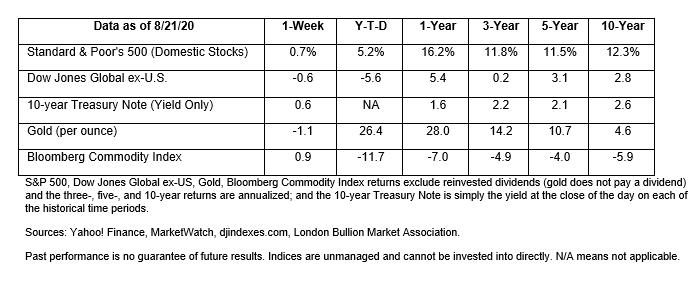Market Insight December 20, 2021
Obviously, there’s been nothing normal about living through a pandemic but before we all get back to being epidemiologists the rest of the year,...

“Inequality has been something that’s been increasingly with us for four decades and it’s not really related to monetary policy.”
-Jerome Powell, Chairman of the @federalreserve (6/10/20)
I already feel bad for this latest exercise in helping hold our Central Planners accountable. I don’t think “Jerome Powell” is a bad guy. In fact, I think he genuinely thinks he’s doing the right thing by debasing the currency of The People in exchange for a few thousand more DOW points into a difficult reelection bid for the man that took a chance on him by appointing a non-econ PhD to the head of the Federal Reserve.
Whether or not said debasement produces the desired outcome remains to be seen. However, one thing is for certain that everyone should be closely watching the underlying volatility of the investment that they own. There are trends developing underneath the surface that aren't captured by an investment asset's price.
The shortest bear market in history is over.
The Nasdaq Composite and Standard & Poor’s 500 Indices finished at new highs last week. The stock market is considered to be a leading economic indicator, so strong stock market performance suggests economic improvement ahead.
There was a caveat to last week’s gains, though. One large technology company was responsible for 60 percent of the S&P’s weekly gains (0.7 percent), reported Ben Levisohn of Barron’s. The same large company is also a component of the Dow Jones Industrials Index, which finished the week flat. Without that stock, the Dow would have finished the week lower. Levisohn wrote:
“The S&P 500 might have hit a record last week, but most stocks have been having bad days. On Friday, for instance, just 220 stocks in the S&P 500 closed higher for the day, and that was far from an anomaly. The S&P 500’s cumulative advance/decline line – a measure of the number of stocks finishing higher versus those finishing lower that technicians use to gauge the market’s underlying strength – has been falling even as the S&P 500 progressed to a record.”
One reason for the U.S. stock market’s rise to date may be dividends, reported Lawrence Strauss of Barron’s. “…equities remain attractive relative to 10-year U.S. Treasuries. The yield on that bond was recently at 0.67 percent, about one percentage point below the S&P 500’s yield.”
The story told by last week’s jobs data was as uncertain as the one told by the U.S. stock market. The Department of Labor reported jobless claims moved higher with 1.1 million people filing new claims for the week of August 15. During the previous week, new claims had fallen below one million. The four-week moving average for new claims continued to trend lower.
The unemployment rate dropped from 10.6 percent to 10.2 percent. That’s an improvement over April’s 14.4 percent, but the rate remains historically high. As a point for comparison, during the Great Recession, the unemployment rate peaked at 10.6 percent in January 2010, according to Rakesh Kochhar of Pew Research Center.
There was also a decline in the number of jobs posted. (Job postings provide insight to labor market activity in real time.) The Indeed Hiring Lab reported postings were down more than 20 percent year-over-year as of August 14, 2020. It was the first decline in the number of job listings since April 2020. Fewer jobs were available in hospitality, tourism, childcare, banking, finance, and software development.

The Annals of Improbable Research publishes “…research that makes people LAUGH, then THINK. Real research, about anything and everything, from everywhere – research that’s maybe good or bad, important or trivial, valuable or worthless.” In that spirit, here are a few notable scientific studies that may inspire awe and/or skepticism:
• Coffee improves longevity. There has been a lot of research exploring whether coffee helps people live longer or shortens their life spans. A metastudy published in the European Journal of Epidemiology found people who drank two to four cups of coffee a day were likely to live longer than those who drank no coffee.
• People don’t know what they don’t know – and they don't know it. The Dunning-Kruger Effect is a cognitive bias in which people wrongly overestimate their knowledge or ability in a specific area. “Not only do these people reach erroneous conclusions and make unfortunate choices, but their incompetence robs them of the metacognitive ability to realize it.” Notably, when the unskilled are trained and develop skills, they recognize the limits of their abilities.
• Insights about alligators on treadmills. Researchers at the University of Utah found, “…alligators, unlike lizards, are able to walk and breathe at the same time by using a rocking pubic bone – part of the pelvis – to help them inhale and exhale,” reported Science Daily. A study published in the Journal of Comparative Physiology reported alligators that trained on treadmills for 15 months improved their peak oxygen rate by 27 percent.
• Arachnids fly the friendly skies. Venomous pseudoscorpions, which are tiny predatory arachnids, have perfected the art of hitchhiking. They attach to flying insects, such as beetles, when they want to travel to new hunting grounds, reported National Museum Publications.
“All sorts of things can happen when you’re open to new ideas and playing around with things.”
--Stephanie Kwolek, Chemist and inventor of Kevlar
Best regards,
Niels Buksik
P.S. Please feel free to forward this commentary to family, friends, or colleagues. If you would like us to add them to the list, please reply to this email with their email address and we will ask for their permission to be added.
* These views are those of ANCHORY LLC, and not the presenting Representative or the Representative’s Broker/Dealer, and should not be construed as investment advice.
*This newsletter was prepared by ANCHORY LLC.
*Government bonds and Treasury Bills are guaranteed by the U.S. government as to the timely payment of principal and interest and, if held to maturity, offer a fixed rate of return and fixed principal value. However, the value of fund shares is not guaranteed and will fluctuate.
*Corporate bonds are considered higher risk than government bonds but normally offer a higher yield and are subject to market, interest rate and credit risk as well as additional risks based on the quality of issuer coupon rate, price,yield, maturity, and redemption features.
*The Standard & Poor's 500 (S&P 500) is an unmanaged group of securities considered to be representative of the stock market in general. You cannot invest directly in this index.
*All indexes referenced are unmanaged. The volatility of indexes could be materially different from that of a client’s portfolio. Unmanaged index returns do not reflect fees, expenses, or sales charges. Index performance is not indicative of the performance of any investment. You cannot invest directly inan index.
*The Dow Jones Global ex-U.S. Index covers approximately 95% of the market capitalization of the 45 developed and emerging countries included in theIndex.
*The 10-year Treasury Note represents debt owed by the United States Treasury to the public. Since the U.S. Government is seen as a risk-free borrower,investors use the 10-year Treasury Note as a benchmark for the long-term bond market.
*Gold represents the afternoon gold price as reported by the London Bullion Market Association. The gold price is set twice daily by the London Gold Fixing Company at 10:30 and 15:00 and is expressed in U.S. dollars per fine troy ounce.
*The Bloomberg Commodity Index is designed to be a highly liquid and diversified benchmark for the commodity futures market. The Index is composed of futures contracts on 19 physical commodities and was launched on July 14, 1998.
*The DJ Equity All REIT Total Return Index measures the total return performance of the equity subcategory of the Real Estate Investment Trust (REIT) industry as calculated by Dow Jones.
*The Dow Jones Industrial Average (DJIA), commonly known as “The Dow,” is an index representing 30 stock of companies maintained and reviewed by the editors of The Wall Street Journal.
*The NASDAQ Composite is an unmanaged index of securities traded on the NASDAQ system.
*International investing involves special risks such as currency fluctuation and political instability and may not be suitable for all investors. These risks are often heightened for investments in emerging markets.
*Yahoo! Finance is the source for any reference to the performance of an index between two specific periods.
*The risk of loss in trading commodities and futures can be substantial. You should therefore carefully consider whether such trading is suitable for you in light of your financial condition. The high degree of leverage is often obtainable in commodity trading and can work against you as well as for you. The use of leverage can lead to large losses as well as gains.
*Opinions expressed are subject to change without notice and are not intended as investment advice or to predict future performance.
*Economic forecasts set forth may not develop as predicted and there can be no guarantee that strategies promoted will be successful.
*Past performance does not guarantee future results. Investing involves risk,including loss of principal.
* The foregoing information has been obtained from sources considered to be reliable, but we do not guarantee it is accurate or complete.
*There is no guarantee a diversified portfolio will enhance overall returns or outperform a non-diversified portfolio. Diversification does not protect against market risk.
*Asset allocation does not ensure a profit or protect against a loss.

Obviously, there’s been nothing normal about living through a pandemic but before we all get back to being epidemiologists the rest of the year,...

THE MARKETS Stimulus talks led investors in a merry dance last week.

To say that this year has been a wild ride is probably an understatement. We have probably seen the worst economic collapse since the Great...